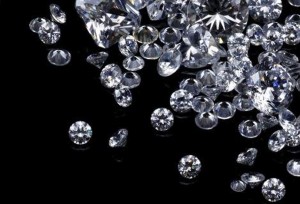How Does an Asteroid Impact Make Diamonds?
Russia says it’s been keeping a huge haul of diamonds—created during an asteroid impact millions of years ago—secret since the 1970s.
By Kathryn Doyle
Russia recently revealed a secret trove of “trillions of carats” of diamonds, under wraps since the ’70s. The crater full of diamonds was created, apparently, 35 million years ago when an asteroid crashed into Siberia. An asteroid 3 to 5 miles across made a 63-mile-wide dent in the Earth, with layers of fine-grain diamonds buried under the surface. Despite the diamonds’ incredible purported value, Russia has not extracted them because the area is too remote and inaccessible, instead (at least according to the Russian government) choosing to keep the area secret for decades.
What Kind of Diamonds are They?
Unless your mate has peculiar taste, you won’t be proposing marriage with one of these. “You’re not going to be making rings out of the stuff,” George Harlow, curator of minerals and gems at the American Museum of Natural History, tells PM. The impact at Popigai created a mixture of traditional, gem-quality cubic diamonds and “lonsdaleite,” tiny yellow-brown crystals with atoms arranged in hexagons. They have the density, hardness, and brightness of the diamonds we know but not much else. When hikers come across these minerals, Harlow says, “people know they’re odd but not that they are diamonds.”
How Does an Asteroid Make Diamonds?
“Those asteroids do all kinds of damage,” says Harlow. “It’s like setting off a nuclear bomb, but bigger.” He says that any space rock hitting Earth since life has existed would have created some diamonds, because the high-pressure impact can wreak havoc with the area’s geology, turning quartz into siderite, making metals if the searing-hot meteorite strikes an ore, and melting sand into glass.
At Popigai where this asteroid struck millions of years ago, the metamorphic rock under the Siberian tundra was full of graphite, which is unusual. Carbon exists in multiple forms, two of which are graphite and diamond. The atoms are the same but their arrangement is different. It takes huge amounts of pressure and very high temperatures to force the graphite atoms from their hexagonal-sheet pattern into the triangular pyramid shape of diamond. The asteroid impact carried such high levels of energy—more than 20 gigapascals, which is more than 100 times the pressure at the bottom of the Marianas Trench—it would have sent a shock wave through the rock and turned the graphite into diamond.
Could Russia Really Have So Many Diamonds? And What Are They Worth?
“There’s a bit of hyperbole going on, trying to get interest in this,” Harlow says. He says the Russian scientists might be right about the number of carats but more important is the concentration. In this case the deposit is spread out over hundreds of kilometers.
Even with a high-quality industrial-grade diamond, worth $12 per carat instead of the usual $6, that won’t defray the cost of extracting them from a remote crater where no existing infrastructure could carry the loads. Plus, synthetic industrial diamonds are cheap and readily available elsewhere. In fact, we’ve been making them since the 1950s.
According to the USGS, 99 percent of industrial diamonds in the U.S. are synthetic and are used to coat the edges of saws for cutting cement, in computer chips, in manufacturing machinery, and in mining. China and the U.S. both produce vast quantities.
Though valuable for scientists, the Russian deposit still needs to prove its economic worth. “I’m not saying it’s phony, not totally a pipedream, but it’s gonna be a hard sell,” says Harlow. “Scientifically it means something. But economically, not yet.” Pure lonsdaleite would theoretically be harder than diamond, making it immensely valuable, but the type of mixture at Popigai includes impurities that make synthetic diamonds more useful for mostapplications.
Are There Other Such Finds Eaiting to be Discovered?
Yes, Harlow says, there are probably more of these types of deposits that we don’t know about. Every asteroid crater would have some, but they could be buried by millions of years of plate tectonics. “Our active planet is constantly erasing its geology,” says Harlow.
by. http://www.popularmechanics.com

